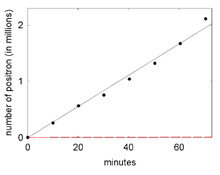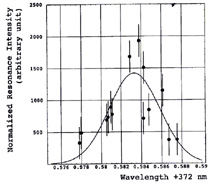

Celebrating the success, the RFQ team
ATRAP: first cold positrons accumulated at the CERN's AD
ATHENA: stored antiprotons
ASACUSA: a new antiprotonic helium laser resonance at 372.583 nm
ATRAP: more than 1000 antiprotons were captured in the first demonstration of antiproton trapping at the Antiproton Decelerator.
�7 May 2001 AD physics has started on schedule in the new millenium, with an antiproton beam more intense than ever (5x107 particles injected every second minute).
�9 April 2001 The AD starts the new millenium with 4 weeks of machine development.
�12 March 2001 The AD machine is currently shut down. The vacuum leak on the ejection kicker magnet has been repaired and a new DC current transformer, able to read a low number of antiprotons, has been installed. The bakeout of the sectors 1 and 2 has been completed; it is going on in sector 4 and is expected to end next week. From week 12 on, during the day, experts will work on the machine inside the tunnel and in the evenings other experts will tests the power supplies, in which case the tunnel will be closed. We shall work in these conditions until the 9th of April, date of the AD start-up.
�30 November 2000 at 8.00 starts the AD shutdown, which will end in Spring 2001
� 10 October 2000 While the foreseen number of antiprotons the AD was supposed to decelerate did not exceed 12 million, the engineers in charge of the machine have succeeded to decelerate more than twice this figure: 27 million.
� 6 October 2000 The Decelerating Radio Frequency Quadrupole (RFQD), constructed at CERN for the ASACUSA collaboration is ready: its aim is to slow down antiprotons leaving the AD to about 50 KeV in energy.
� 29 August 2000 The ATRAP Collaboration has accumulated the first cold positrons at CERN's AD . ATRAP now has both of the ingredients of cold antihydrogen in the same trap structure at the same time.
� 23 August 2000 Another new resonance, (36,34)-(37,33) was discovered at 616 nm by the ASACUSA Collaboration.
� 11 August 2000 Antiprotons have been captured and stored for up to one minute by the ATHENA experiment
� 1 August 2000 A few thousand antiprotons captured by the ATHENA collaboration
� 24-25 July 2000 ASACUSA did a lifetime and initial population measurement of the (35,34) state of the antiprotonic helium, using the newly discovered resonance at 372 nm
� 18 July 2000 The ASACUSA experiment found the first new physics result at the AD: a new antiprotonic helium laser resonance at 372.583 nm
� 18 July 2000 The ATRAP Collaboration has trapped antiprotons in the small volume of an ion trap using antiprotons supplied by CERN's new antimatter factory, the Antiproton Decelerator (AD).
� 29 June 2000 The AD team produced today CERN's first antiproton beam for the year 2000. With the beam now ready, the three experiments can begin running, as scheduled, during the next few weeks.
� 10 May 2000 During the live webcast, the AD team did the first antiproton injection to the AD, which began just before the program started.
� 2 December 1999 The heroic efforts of the AD team (led by Stephan Maury of PS division) paid off: antiprotons were at last delivered to the ASACUSA collaboration's cold helium gas target and produced a familiar sight on their computer screens
� 29 November 1999 Physicists at the AD have succeeded in slowing down antiprotons, proving for the first time that the AD works well with antiprotons.
� 9 August 1999 For the first time at the AD, a proton beam has been decelerated from its initial momentum of 3.5 GeV/c to the target momentum of 100 MeV/c.
� 9 November 1998 A major milestone has been reached when the first beam of protons has been injected into the new AD machine.




